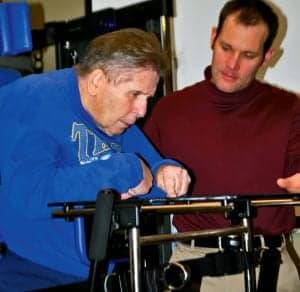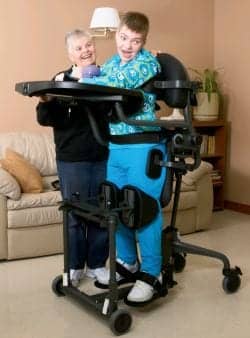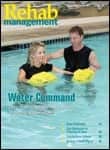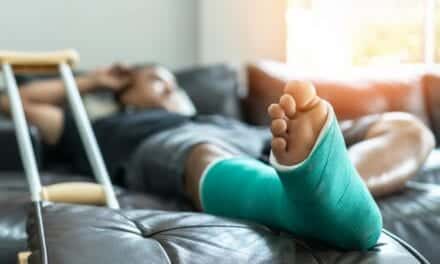This is Part One of a three part series about standing systems, lifts, and body weight support unitis.

Mike Studer, PT, MHS, NCS, CEEAA, shown in therapy adjusting a standing frame for a patient with anoxic brain injury.
The act of standing upright is a natural inclination for our species, and it also yields physical and psychological benefits for patients with a variety of conditions (see Table 1). Standing frames are designed to harness these benefits for patients with impairments across any of the body systems listed in the Guide to PT practice (integumentary, neuromuscular, musculoskeletal, cardiovascular/pulmonary). The devices can also help patients attain or recapture some of the roles and responsibilities listed in the International Classification of Function (ICF).1
The advantages standing frames provide to patients are clear; however, the necessary steps to obtain the funding, recommendation, and selection of a standing frame may not be. This article is meant to arm therapists who have little to no experience in prescribing or advocating a standing frame with a solid foundation of knowledge encompassing common conditions that warrant a standing frame, the most effective recommendation methods, avenues to prevent funding denials, and standing system features.
COMMON CONDITIONS WARRANTING A STANDING FRAME
The most common diagnostic codes utilized in standing frame funding are listed in Table 1. This is not intended to be an exhaustive or all-inclusive list. Standing frames can be used to advance an upright progression in the case of acute incomplete paraplegia or to arrest an impairment that interferes with functional independence (contracture).
INITIATING AND REINFORCING A STANDING FRAME RECOMMENDATION

Prolonged standing offers physiologic and psychological benefits.
TABLE 1. Common conditions and ICD-9s warranting a standing frame
Paraplegia
Quadriplegia
Cerebral palsy
Multiple trauma
Traumatic brain injury
Once the medical team has decided a standing frame will advance a patient’s condition or independence, it is time to make a recommendation for a standing frame. To reinforce the recommendation, follow these steps:
- Identify the time frame, body systems impacted (Table 2), and qualifying diagnosis (Table 1).
- Confirm DME benefit and insurance policy that is in effect. Be sure to also identify a local vendor that can provide equipment through this insurance.
- Make specific recommendations based on transfers and prognosis for functional change. Consider how the patient currently transfers (lift, stand pivot, sliding board).
- Take measurements (height, weight to start) and document three trials of standing frames to identify the decision-making process.
- Write a specific home standing frame protocol for this patient.
- Identify any options that have been considered: bracing, injections, or surgery.2
PREVENTING FUNDING DENIALS
It is not uncommon for a funding source to initially deny a standing frame. Do not be discouraged. To expedite the process and prevent repeated denials, the medical team should adhere to some helpful hints. The hints listed below are based on personal experience and conversations with other therapists:
- Denials are minimized when they include patient-specific information, compared to a form letter approach.
- When a stander is indicated, make an initial request for a wheelchair and standing frame together.
- Document three trials of different standing frames in your supportive documentation.
- Incorporate information about how a patient transfers. A device that is more practical will be used more frequently, so consider using a swivel seat entry for patients who transfer by lift, etc.
- Plan for the long term. For patients who will be progressing toward independence in achieving standing, a manually adjustable hydraulic lift that can be set at varying degrees of assistive standing may be best.
- Use objective data related to safety and independence in documenting the need for and progression of this or any other assistive device.
- Listen to the patient and family about what they want and expect from the device.
- Therapists often write a letter of medical necessity that is subsequently signed by an MD.
- Be sure to not omit objective measures in the documentation. Examples of these measures include standing endurance/tolerance, range of motion (ROM), and orthostatics.
- Do not set goals of strength as measured by manual muscle testing for standing frames.
STANDING SYSTEMS AND FEATURES
TABLE 2. Body systems benefited through prolonged standing
Physiologic and psychological benefits
Integumentary
(position changes and pressure redistribution)
Cardiopulmonary
(standing only and with glider option)
Gastric and urinary
Neuromuscular
(trunk control, spasticity)
Musculoskeletal
(bone density, joint contractures, flexibility)
Psychosocial—self-esteem
To make the most effective recommendations, therapists must be familiar with the various options available in a standing frame. Here are some of the most common features, along with a brief description as needed:
- Swivel seat (rotates 90 degrees and locks) or rotating disc within a stationary seat.
- Casters to move the stander and wheels for independent self-mobility in standing.
- Gliders (an elliptical-type design with arm and leg motion).
- Standers may passively support full standing or varied degrees approaching standing.
- Mobile standers are often operated using a bimanual crank to roll the unit forward.
To best accommodate lifts and transfers of all types, standing frames now come with different specifications including removable trays, backrests, legrests, and elevated base legs (affording clearance for lifts to approach).
To ensure success in advocating a standing frame, it is vital to remember that the process includes a well-thought-out plan that encompasses a qualifying condition with ICD 9, body systems (Guide to PT practice) that would be impacted with a stander, objective measures, goals (ICF), and a time frame (lifetime, etc). Individualizing a letter of medical necessity (LOMN) with any patient-specific goals or unique characteristics of this case can be instrumental in preventing repeated denials.
Mike Studer, PT, MHS, NCS, CEEAA, is a full-time clinician at Northwest Rehabilitation Associates in Salem, Ore. He is a board-certified neurologic clinical specialist and certified exercise expert for aging adults. He has been a PT for 21 years and is the current Chair of the Geriatric Section—APTA Balance and Falls Special Interest Group. For more information, contact .
REFERENCES
- Sullivan KJ, Cen SY. Model of Disablement and Recovery: Knowledge Translation in Rehabilitation Research and Practice. Phys Ther. 2011 Oct 14. [Epub ahead of print]
- Gibson SK, Sprod JA, Maher CA. The use of standing frames for contracture management for nonmobile children with cerebral palsy. Int J Rehabil Res. 2009;32(4):316-23.





